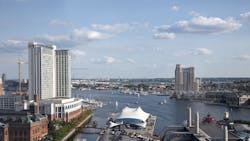45 Million Gal of Sewage and Storm Water Mix Flows into Baltimore Water
From July 21 to 25, 2018, Baltimore’s sewer system was inundated with record rainfall levels, causing a flow of approximately 45 million gal of sewage and storm water to flow into the city’s streams and harbors.
According to Baltimore’s Department of Public Works, sewage continued to flow into the city’s waterways at two additional locations through Monday, July 30, 2018, following the initial surge from July 21 to 25. These additional ruptures were caused by separate line ruptures, according to public works spokesman Jeffrey Raymond.
The department is planning to apply bypass pumping to the two ruptured sites once the stream stops. It is currently unknown how much additional sewage or storm water material has flowed from the additional ruptures, but Raymond claims the department is working diligently to resolve the issue.
“We’re working hard to get them bypassed and isolated,” Raymond said.
Once the discharge figures are known by the city, the data will be released to the public.
These incidents come as a direct result of the wettest July the city of Baltimore has ever experienced. This occurrence also follows another significant discharge event in May, when 10 million gal of similar material flowed into Jones Falls in the midst of flooding.
Both overflow incidents come in the process of Baltimore attempting to comply with a consent decree to completely eliminate such overflows by the year 2022. Doing so is necessary for the city to achieve compliance with federal Clean Water Act standards.
